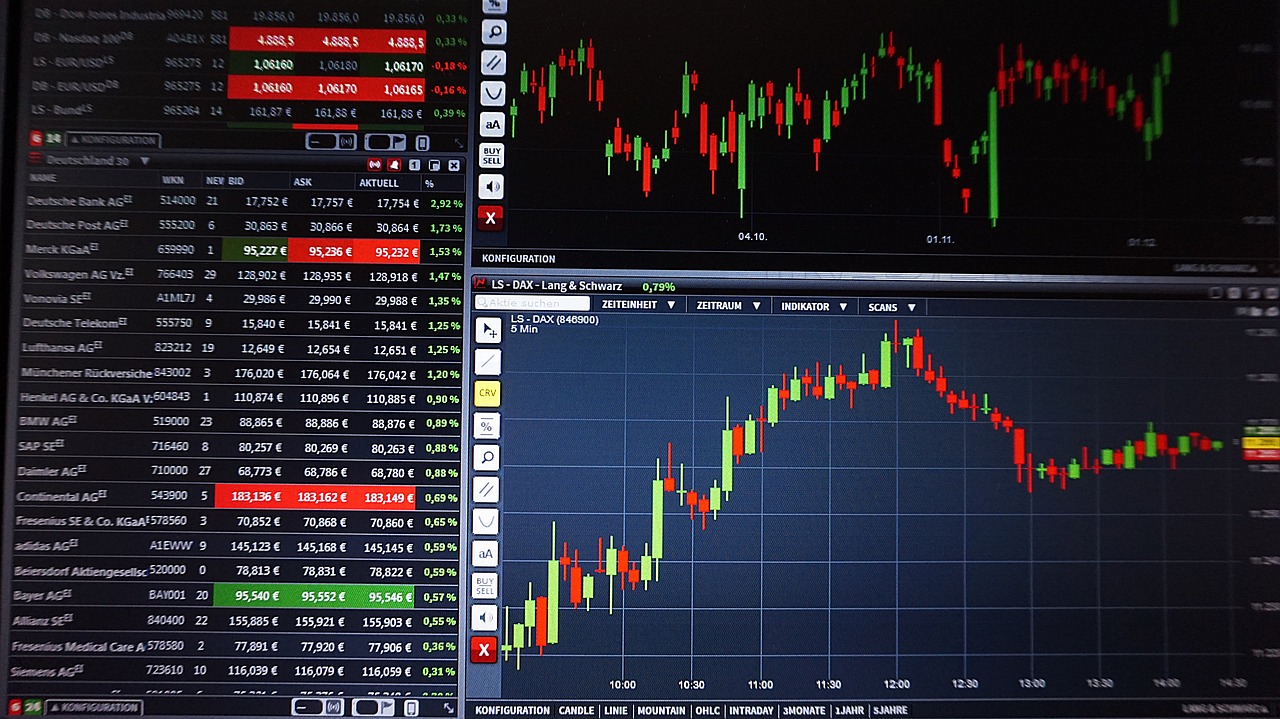Swing Trading Strategies for Busy Professionals
In today's fast-paced world, balancing work commitments and personal life can feel like juggling flaming swords. For busy professionals, finding a way to invest without sacrificing precious time is a challenge. Enter swing trading—a strategy that allows you to capitalize on market opportunities while still managing your daily responsibilities. This article dives into effective swing trading strategies designed specifically for those who are short on time but big on ambition. With the right techniques and tools, you can maximize your profits without feeling overwhelmed.
Swing trading is a medium-term trading strategy that aims to capture price movements over days or weeks. Unlike day trading, which requires constant monitoring of the market, swing trading allows you to enter and exit trades based on short to medium-term price trends. Think of it as fishing; you cast your line and wait for the right moment to reel in your catch. This approach is distinct from long-term investing, where you hold stocks for years, often ignoring short-term fluctuations. Swing traders are like surfers, riding the waves of price movements without getting caught in the undertow.
So why should busy professionals consider swing trading? The answer lies in its numerous advantages. Firstly, swing trading offers remarkable flexibility. You can analyze the market and place trades during your downtime, whether it's during lunch breaks or after hours. Secondly, it requires a lower time commitment compared to day trading, allowing you to maintain a balanced work-life schedule. Lastly, the potential for significant profits is enticing. With the right strategy, you can achieve impressive returns without dedicating your entire day to trading.
One of the primary benefits of swing trading is its time efficiency. Unlike day traders who need to monitor the market constantly, swing traders can check their positions a few times a day or even less. This means you can focus on your job or personal life while still engaging in the market. Imagine being able to invest your money effectively without having to drop everything to watch stock charts. Swing trading allows you to enjoy your life while still making your money work for you.
Establishing achievable profit targets is crucial for success in swing trading. It's vital to set goals that align with your trading style and time constraints. For instance, if you're a busy professional, aiming for a 5% return on investment over a few weeks is more realistic than chasing after 20% returns in a matter of days. By setting realistic goals, you not only keep your expectations in check but also reduce the stress that often accompanies trading. Remember, patience is key in the world of swing trading.
In our tech-savvy world, leveraging technology can significantly enhance your swing trading efficiency. There are numerous trading apps and platforms that provide real-time alerts, market analysis, and charting tools. For busy professionals, these tools are invaluable. They allow you to stay informed about market movements without having to be glued to your screen. Imagine receiving a notification on your phone about a stock that meets your criteria while you're in a meeting. With the right tools, you can make timely decisions without missing a beat in your professional life.
Effective risk management is vital in swing trading. It's not just about making profits; it's also about protecting your investments. Techniques such as setting stop-loss orders and diversifying your portfolio can help minimize losses. For instance, if you invest in multiple stocks across different sectors, you're less likely to feel the impact of a downturn in one particular area. Remember, trading without a risk management plan is like sailing without a life jacket—you're just asking for trouble.
Selecting the right stocks is critical for successful swing trading. You want to look for stocks that have shown volatility and are likely to make significant price movements. Criteria for stock selection can include recent news, earnings reports, and technical indicators. By focusing on stocks that fit your trading strategy, you increase your chances of success. It's like being a chef; you need the right ingredients to whip up a delicious dish.
Understanding technical analysis is key for swing traders. This involves studying price charts and using indicators to predict future movements. Essential chart patterns, such as head and shoulders or flags, can provide insights into potential price shifts. Indicators like moving averages and RSI (Relative Strength Index) help you gauge market momentum. By mastering these tools, you can make informed trading decisions that align with your goals.
Incorporating fundamental analysis alongside technical analysis can provide a more comprehensive view. Evaluating a company's financial health, market trends, and economic indicators can help you identify potential candidates for swing trading. Think of it as knowing the backstory of a movie before watching it; the more you know, the better your decisions will be. By combining both analyses, you can enhance your trading strategy and increase your chances of success.
A well-structured trading plan is essential for swing trading success. Your plan should include key components such as entry and exit strategies, risk management protocols, and performance evaluation methods. By having a clear plan in place, you can navigate the market with confidence and reduce emotional decision-making. It's like having a roadmap on a long journey; it guides you and helps you stay on track.
Backtesting your swing trading strategies can help refine your approach. By testing your strategies against historical data, you can identify what works and what doesn’t. This process allows you to make adjustments before risking real money. Think of it as practicing for a big performance; the more you rehearse, the more confident you become when it's showtime.
The trading landscape is constantly evolving, and staying competitive requires continuous learning and adaptation. Markets change, and new strategies emerge, so it's crucial to keep your knowledge fresh. Engage in trading communities, read books, and attend webinars to stay updated. By being proactive in your learning, you can adapt your strategies and remain successful in swing trading.
- What is swing trading? Swing trading is a trading strategy that aims to capture short to medium-term price movements in stocks or other assets.
- How much time do I need to dedicate to swing trading? Swing trading requires less time than day trading, as you can check your trades a few times a day or even less.
- What tools should I use for swing trading? Utilize trading apps, charting tools, and market alerts to enhance your trading efficiency.
- Is risk management important in swing trading? Yes, effective risk management is crucial to protect your investments and minimize losses.

Understanding Swing Trading
Swing trading is a fascinating and dynamic trading strategy that sits comfortably between day trading and long-term investing. Imagine it as a dance where traders aim to capture the rhythm of price movements over a period of days to weeks. Unlike day traders who scramble to make quick profits within a single day, or long-term investors who hold onto their stocks for years, swing traders look for opportunities that arise within a shorter time frame. This approach allows them to capitalize on market fluctuations without the pressure of constant monitoring.
At its core, swing trading is about identifying trends and making informed decisions based on price patterns. Traders analyze various factors, including market sentiment, economic indicators, and technical signals. By doing so, they can spot potential entry and exit points that align with their trading goals. Think of swing trading as a surfer waiting for the perfect wave; it requires patience, timing, and the ability to ride the momentum without getting wiped out.
One of the key distinctions of swing trading is its focus on capturing 'swings' in the market. These swings can be influenced by various elements, such as earnings reports, economic news, or even geopolitical events. For busy professionals, this makes swing trading an appealing option. You don’t need to be glued to your trading screen all day. Instead, you can set your sights on specific stocks and monitor them at your convenience, making it a more manageable choice for those juggling work and personal commitments.
In summary, swing trading is a versatile strategy that offers flexibility and the potential for significant returns. It's not just about making quick trades; it's about understanding the market's ebb and flow and positioning yourself to take advantage of those movements. As we dive deeper into swing trading strategies, you'll discover how to harness the power of this approach effectively, even with a busy schedule.

Key Benefits of Swing Trading
Swing trading is like the sweet spot of the trading world, especially for busy professionals juggling multiple responsibilities. It offers a unique blend of flexibility and potential profitability that can fit seamlessly into a hectic lifestyle. One of the standout benefits of swing trading is its time efficiency. Unlike day trading, which requires constant monitoring of the markets, swing traders can make their moves based on daily or weekly price fluctuations. This means you can have a full-time job, attend to family obligations, or even enjoy your hobbies without feeling tethered to your trading screen.
Moreover, swing trading allows you to capitalize on market trends without the need for a significant time commitment. Imagine being able to analyze a stock's performance, make a calculated decision, and then step away for a few days or even a week. This is particularly appealing for those who don’t have the luxury of spending hours glued to their computers. You can check your trades during lunch breaks or after work, making it an ideal strategy for those with a packed schedule.
Another major advantage is the potential for significant profits. By holding onto stocks for several days or weeks, swing traders can benefit from larger price movements compared to day trading, where profits are often limited to smaller fluctuations. This means that with the right strategy, you can achieve impressive returns on your investments without needing to devote every waking moment to market analysis.
However, it’s not just about profit potential. Swing trading also allows for a more balanced lifestyle. It encourages traders to set realistic goals and develop a disciplined approach to investing. By establishing achievable profit targets, you can avoid the emotional rollercoaster that often comes with trading. This discipline is crucial, as it helps you maintain a clear head and make informed decisions rather than reacting impulsively to market changes.
To illustrate the benefits further, let’s take a look at a comparison of swing trading versus day trading:
| Aspect | Day Trading | Swing Trading |
|---|---|---|
| Time Commitment | High | Moderate |
| Profit Potential | Limited to Daily Fluctuations | Greater Price Movements Over Days/Weeks |
| Emotional Stress | High | Lower |
| Flexibility | Low | High |
In summary, swing trading is particularly well-suited for busy professionals due to its time efficiency, potential for significant profits, and ability to foster a balanced lifestyle. By leveraging this trading style, you can achieve your financial goals without sacrificing your personal life or well-being.
1. What is the best time frame for swing trading?
Swing traders typically look at time frames ranging from a few days to several weeks. This allows them to capitalize on intermediate price movements without the need for constant monitoring.
2. Do I need a lot of money to start swing trading?
No, you don't need a significant amount of capital to start swing trading. Many brokers offer accounts with low minimum deposits, allowing you to begin with a modest investment.
3. How do I choose the right stocks for swing trading?
Selecting stocks for swing trading involves looking for those with good volatility, strong trends, and adequate volume. Utilizing technical analysis tools can also aid in identifying potential candidates.
4. Can I swing trade part-time?
Absolutely! Swing trading is designed for those who cannot dedicate their entire day to trading. It allows for flexibility, making it perfect for part-time traders.

Time Efficiency
When it comes to swing trading, **time efficiency** is not just a luxury; it's a necessity, especially for busy professionals juggling multiple responsibilities. Imagine trying to catch a bus while simultaneously answering work emails—it's a recipe for chaos! Swing trading allows you to step back from the frantic pace of day trading, where every tick of the market demands your attention, and instead, you can focus on capturing price movements over several days or weeks. This means you can analyze your trades during your lunch break or after hours, giving you the flexibility to maintain your professional commitments without sacrificing your trading ambitions.
One of the most appealing aspects of swing trading is that it requires significantly less time in front of the screen compared to day trading. Instead of constantly monitoring charts, you can set your trades and let them run, checking in periodically to make adjustments as needed. This approach not only protects your time but also reduces stress. Think of it as setting a slow cooker for a delicious meal; you can go about your day while it does the hard work for you.
Moreover, leveraging technology can enhance your time efficiency in swing trading. There are numerous trading platforms and mobile apps available that allow you to set alerts for price movements, so you don't have to keep your eyes glued to the screen. For instance, you can set up alerts for when a stock hits a specific price point or when technical indicators signal a buying opportunity. This way, you can engage with the market only when it matters most, freeing up your schedule for other important tasks.
To illustrate just how effective swing trading can be, consider the following table that contrasts the time commitment required for different trading styles:
| Trading Style | Time Commitment (per day) | Ideal for |
|---|---|---|
| Day Trading | 4-8 hours | Full-time traders |
| Swing Trading | 1-2 hours | Busy professionals |
| Long-term Investing | Minimal (weekly/monthly) | Retirement savers |
In conclusion, swing trading offers a practical solution for busy professionals who want to engage in the stock market without dedicating their entire day to it. By setting realistic goals, utilizing technology, and adopting a strategic approach, you can maximize your trading potential while maintaining a balanced lifestyle. So, why not take the plunge into swing trading and reclaim your time?

Setting Realistic Goals
When diving into the world of swing trading, one of the most crucial steps is . Just like planning a road trip, you wouldn’t set off without knowing your destination and the route you’ll take. Similarly, in trading, having clear, attainable objectives can help you navigate the often unpredictable markets. So, how do you go about defining these goals in a way that aligns with your busy lifestyle?
First off, it’s essential to understand that swing trading is not a get-rich-quick scheme. It requires patience and a level-headed approach. Setting your sights on achievable profit targets is vital. For instance, instead of aiming for a 100% return in a month, which is unrealistic for most, consider setting a goal of 5-10% per trade. This approach not only makes your targets more manageable but also reduces the pressure that can lead to hasty decisions.
Another aspect to consider is the time frame for your goals. Given that you’re likely juggling work and personal commitments, it’s important to set time-bound objectives. Ask yourself questions like:
- How many trades can I realistically manage in a week?
- What is my available time for research and analysis?
- Am I willing to adjust my goals based on my performance?
By reflecting on these questions, you can create a more personalized trading plan. For example, if you decide that you can dedicate a few hours each weekend to analyze stocks, you might set a goal to identify and execute two new trades every month. This way, you’re not overwhelmed, and you can still make progress towards your financial aspirations.
Additionally, consider incorporating a review system into your goal-setting process. Regularly assess your performance against your goals. Are you hitting your targets, or do you need to adjust them? This reflection can be likened to tuning a musical instrument; it ensures you’re always in harmony with the market's rhythm. You might even want to keep a trading journal where you note your trades, the rationale behind them, and the outcomes. This practice can provide insights that will help refine your strategies over time.
Ultimately, the key to successful swing trading lies in balance and adaptability. By setting realistic goals that fit within your lifestyle, you can cultivate a sustainable trading practice that works for you. Remember, it’s not about how fast you can achieve your goals, but rather how consistently you can work towards them without compromising your daily life.
Here are some common questions that busy professionals often have regarding swing trading and goal setting:
- How much time should I dedicate to swing trading each week? It varies by individual, but many find that dedicating a few hours on weekends for research and analysis, along with brief daily check-ins, works well.
- What profit percentage should I aim for? Aiming for 5-10% per trade is a realistic target for many swing traders, especially when starting.
- How do I know if my goals are realistic? Regularly assess your trading performance and adjust your goals based on your experiences and market conditions.

Utilizing Technology
In today's fast-paced world, busy professionals need every advantage they can get, especially when it comes to swing trading. Thankfully, technology has come to the rescue, offering a plethora of tools that can streamline the trading process and enhance efficiency. Imagine being able to analyze market trends, set alerts, and execute trades—all from the palm of your hand! With the right technology, you can transform the way you approach trading, making it not only more manageable but also more profitable.
One of the most significant advancements in trading technology is the rise of mobile trading apps. These apps allow you to monitor your investments and execute trades anytime, anywhere. Whether you're at the office, commuting, or enjoying a weekend getaway, you can stay on top of your swing trading game. Popular apps like TD Ameritrade's thinkorswim and Robinhood provide user-friendly interfaces and powerful tools that can help you make informed decisions on the go.
Moreover, setting up real-time alerts is a game-changer for busy traders. Imagine receiving a notification on your phone when a stock reaches a specific price point or when a particular technical indicator signals a buying opportunity. This feature allows you to act quickly without having to monitor the market constantly. You can customize these alerts based on your trading strategy, ensuring you never miss out on a potential profit.
Additionally, leveraging charting software can significantly enhance your technical analysis skills. Many platforms offer advanced charting tools that allow you to visualize price movements, apply various indicators, and identify patterns with ease. This capability is essential for swing traders who rely on technical analysis to make informed decisions. Knowing when to enter or exit a trade can mean the difference between profit and loss.
Furthermore, consider using social trading platforms where you can connect with other traders, share insights, and even follow successful traders’ strategies. This collaborative approach not only enriches your knowledge but also helps you stay updated on market trends. Platforms like eToro allow you to see what others are trading and can provide inspiration for your own strategies.
Lastly, don't underestimate the power of automated trading systems. These systems can help you execute trades based on predefined criteria, reducing the emotional stress that often comes with trading. By automating your strategy, you can ensure that your trades are executed at the right time without second-guessing yourself. This is particularly beneficial for busy professionals who may not have the time to analyze every market movement.
In conclusion, utilizing technology in swing trading not only makes the process more efficient but also opens up new avenues for maximizing profits. By incorporating mobile apps, real-time alerts, advanced charting tools, social trading platforms, and automated systems into your trading routine, you can navigate the market with confidence, even with a packed schedule. So, why not embrace these technological advancements and take your swing trading to the next level?
- What is swing trading?
Swing trading is a trading strategy that aims to capture short- to medium-term price movements in stocks or other financial instruments over a period of days to weeks. - How much time do I need to dedicate to swing trading?
One of the benefits of swing trading is that it requires less time than day trading. You can spend a few hours each week analyzing stocks and managing your trades. - What tools should I use for swing trading?
Essential tools include mobile trading apps, charting software, and platforms for setting real-time alerts. These can help you stay informed and make timely decisions. - Can I swing trade part-time?
Yes! Swing trading is ideal for busy professionals as it allows you to trade without needing to monitor the market constantly.

Risk Management Techniques
This article explores effective swing trading strategies tailored for busy professionals, focusing on time-efficient techniques and tools that can help maximize profits without overwhelming schedules.
Swing trading is a medium-term trading strategy that aims to capture price movements over days or weeks. This section will explain its fundamentals and how it differs from day trading and long-term investing.
Swing trading offers several advantages for busy professionals, including flexibility, lower time commitment, and the potential for significant profits. Here, we’ll outline why this strategy is particularly suited for those with limited trading time.
One of the primary benefits of swing trading is its time efficiency. Professionals can manage their trades without needing to monitor the market constantly, allowing for a balanced work-life schedule.
Establishing achievable profit targets is crucial for success in swing trading. This section will discuss how to set realistic goals that align with your trading style and time constraints.
Leveraging technology, such as trading apps and alerts, can enhance swing trading efficiency. We will explore the best tools that can help busy professionals stay informed and make timely decisions.
Effective risk management is vital in swing trading. Without it, even the most promising trades can lead to significant losses. So, how can busy professionals protect their investments while navigating the unpredictable waters of the stock market? It all boils down to a few key techniques.
First and foremost, position sizing is essential. This involves determining how much of your total capital you are willing to risk on a single trade. A common rule of thumb is to risk no more than 1-2% of your total trading capital on any given trade. This way, even a series of losses won't drastically affect your portfolio.
Next, consider implementing stop-loss orders. A stop-loss order is a predetermined price at which you will exit a losing trade. This technique helps you cut losses early and protects your capital. For instance, if you buy a stock at $50, you might set a stop-loss at $48. If the stock drops to that price, your order will trigger, selling the stock and limiting your loss.
Additionally, diversification plays a crucial role in risk management. By spreading your investments across various sectors or asset classes, you reduce the impact of a poor-performing stock on your overall portfolio. For busy professionals, this means not putting all your eggs in one basket, which can be particularly tempting when time is limited.
Lastly, keeping an eye on market conditions and news can help you make informed decisions. The market can be influenced by various factors, including economic indicators, geopolitical events, and company news. By staying updated, you can adjust your strategies accordingly and mitigate risks.
In summary, effective risk management in swing trading involves:
- Determining appropriate position sizes
- Setting stop-loss orders to limit losses
- Diversifying your investments
- Staying informed about market conditions
By incorporating these techniques, busy professionals can create a more sustainable trading approach that balances the potential for profit with the need to protect their investments.
Selecting the right stocks is critical for successful swing trading. Here, we’ll discuss criteria for stock selection and how to identify potential candidates that fit your trading strategy.
Understanding technical analysis is key for swing traders. This section will introduce essential chart patterns and indicators that can help professionals make informed trading decisions.
Incorporating fundamental analysis alongside technical analysis can provide a more comprehensive view. We’ll discuss how to evaluate financial health and market trends when selecting stocks for swing trading.
A well-structured trading plan is essential for swing trading success. This section will outline the key components of a trading plan tailored for busy professionals, including entry and exit strategies.
Backtesting your swing trading strategies can help refine your approach. Here, we’ll discuss methods to test your strategies against historical data to improve future performance.
The trading landscape is constantly evolving. This section emphasizes the importance of continuous learning and adapting strategies to stay competitive in swing trading.
Q: What is swing trading?
A: Swing trading is a trading strategy that aims to capture short- to medium-term price movements in stocks or other assets over a few days to weeks.
Q: How much time do I need to dedicate to swing trading?
A: While swing trading requires monitoring your trades, it generally demands less time than day trading, making it suitable for busy professionals.
Q: What are the risks associated with swing trading?
A: Risks include market volatility, poor stock selection, and the potential for significant losses if not managed properly. Effective risk management techniques can help mitigate these risks.
Q: Can I swing trade part-time?
A: Yes, many busy professionals successfully swing trade part-time by using technology and setting a structured trading plan.

Choosing the Right Stocks
When it comes to for swing trading, it's essential to adopt a strategic approach. The stock market is vast and diverse, filled with countless opportunities and challenges. For busy professionals, the process can feel overwhelming. However, by focusing on key criteria, you can streamline your selection process and enhance your chances of success. Think of stock selection like preparing a meal; you need the right ingredients to create a delicious dish. In this case, those ingredients are the stocks you choose to trade.
First, consider the volatility of the stocks you are interested in. Swing trading benefits from price movements, so selecting stocks that show consistent volatility is crucial. Look for stocks that have a history of making significant price swings over a few days or weeks. This volatility can be measured through indicators like the Average True Range (ATR), which provides insight into how much a stock typically moves within a given period. A higher ATR indicates more potential for profit, but it also comes with increased risk.
Another vital factor to consider is the liquidity of the stocks. Liquidity refers to how easily a stock can be bought or sold without affecting its price. High liquidity ensures that you can enter and exit trades quickly, which is particularly important for swing traders who may need to act fast. Stocks that are part of major indices like the S&P 500 or those with high trading volumes are often more liquid and thus more suitable for swing trading.
Additionally, incorporating both technical and fundamental analysis into your stock selection process can provide a well-rounded view of potential candidates. Technical analysis involves studying price charts and patterns to predict future movements, while fundamental analysis focuses on a company's financial health and market position. For instance, if a stock shows a bullish pattern on the chart and has strong earnings reports, it could be a strong candidate for a swing trade.
Here are some criteria to keep in mind while selecting stocks:
- Market Trends: Pay attention to the overall market trends. Are you trading in a bull market or a bear market? This can influence your stock choices.
- Sector Performance: Certain sectors perform better than others at different times. Research which sectors are currently in favor and consider stocks within those sectors.
- News and Events: Stay informed about any news or events that could impact stock prices. Earnings reports, product launches, or regulatory changes can create opportunities.
Moreover, it’s beneficial to maintain a watchlist of potential stocks. This list can include stocks that meet your criteria but may not be ready for a trade yet. By observing these stocks, you can identify the right moment to enter a trade based on your analysis. Think of your watchlist as a fishing line; you cast it out and wait for the right catch to bite.
Lastly, don’t forget to trust your instincts and experience. As you gain more knowledge and experience in swing trading, you’ll develop a sense of which stocks resonate with your trading style. Remember, even the best traders started somewhere, and learning from your successes and failures is part of the journey. So, take your time, do your research, and choose stocks that align with your trading goals.
Q1: How do I know if a stock is volatile enough for swing trading?
A1: Look for stocks with a high Average True Range (ATR) and those that frequently make significant price movements over short periods.
Q2: What tools can help me analyze stocks for swing trading?
A2: Utilize trading platforms that offer charting tools, technical indicators, and news feeds to stay informed about market trends and stock performance.
Q3: Is it necessary to perform both technical and fundamental analysis?
A3: While it's not mandatory, combining both analyses can provide a more comprehensive view of potential trades and increase your chances of success.

Technical Analysis Basics
When diving into the world of swing trading, understanding technical analysis is like having a compass in uncharted waters. It helps you navigate the complex sea of stock price movements and trends. At its core, technical analysis involves evaluating securities by analyzing statistics generated by market activity, primarily price and volume. Unlike fundamental analysis, which looks at a company's financial health and economic factors, technical analysis focuses solely on price patterns and market behavior.
One of the fundamental concepts in technical analysis is the chart. Charts provide a visual representation of price movements over time, allowing traders to identify trends and potential reversals. There are several types of charts, but the most commonly used are line charts, bar charts, and candlestick charts. Each has its unique advantages:
- Line Charts: These are the simplest form of charts that connect closing prices over a specified period, giving a clear view of the overall trend.
- Bar Charts: These charts provide more information, displaying the open, high, low, and close (OHLC) prices for a specific period.
- Candlestick Charts: Similar to bar charts, but they use colored bodies to indicate price movement direction, making them visually appealing and easier to interpret.
Once you’re comfortable with charts, the next step is to learn about indicators. Indicators are mathematical calculations based on price and volume, and they help traders make informed decisions. Some popular indicators include:
- Moving Averages: These smooth out price data to identify trends over time. A simple moving average (SMA) can help you see the general direction of a stock.
- Relative Strength Index (RSI): This momentum oscillator measures the speed and change of price movements, helping traders identify overbought or oversold conditions.
- Bollinger Bands: These consist of a middle band (SMA) and two outer bands that indicate volatility and potential price movements.
Understanding support and resistance levels is also crucial in technical analysis. Support is the price level where a stock tends to stop falling and may bounce back up, while resistance is where it struggles to rise above. These levels can provide valuable insights into potential entry and exit points for swing traders.
To sum it up, mastering technical analysis is essential for busy professionals looking to make informed swing trading decisions without spending all day glued to their screens. By utilizing charts, indicators, and understanding support and resistance levels, you can enhance your ability to predict market movements effectively. Remember, the goal is to make your trading as efficient as possible, allowing you to balance your professional life while still pursuing profitable trading opportunities.
Q: What is the main goal of technical analysis?
A: The main goal of technical analysis is to forecast future price movements based on historical price data and market trends.
Q: Can I use technical analysis for all types of trading?
A: Yes, technical analysis can be applied to various trading styles, including day trading, swing trading, and long-term investing. However, its effectiveness may vary depending on the trader's strategy.
Q: Do I need to be a math expert to understand technical analysis?
A: No, while some mathematical concepts are involved, many tools and indicators are user-friendly and designed for traders of all skill levels.
Q: How can I start learning technical analysis?
A: There are numerous resources available, including online courses, books, and trading platforms that offer tutorials on technical analysis basics.

Fundamental Analysis Considerations
When it comes to swing trading, diving into fundamental analysis is like getting to know the heartbeat of a company. While technical analysis focuses on price movements and chart patterns, fundamental analysis digs deeper into the underlying factors that drive a stock's performance. For busy professionals, understanding these fundamentals can provide a more comprehensive view of potential trades, allowing you to make informed decisions without needing to monitor the market constantly.
So, what should you look for when conducting fundamental analysis? First and foremost, it's essential to evaluate a company's financial health. This involves examining key financial statements such as the income statement, balance sheet, and cash flow statement. These documents reveal crucial details about a company's profitability, debt levels, and cash flow management. For instance, a company with a strong revenue growth trend and manageable debt is often a more attractive candidate for swing trading.
Another critical aspect of fundamental analysis is understanding market trends. This means keeping an eye on broader economic indicators, such as interest rates, inflation, and employment data. These factors can significantly influence stock prices. For example, if the economy is booming and consumer spending is up, companies in the retail sector may experience a surge in their stock prices. Conversely, during economic downturns, stocks in certain sectors may falter.
Additionally, you should pay attention to industry-specific metrics. Different sectors have unique benchmarks that can help you assess a company's performance relative to its peers. For example, if you’re looking at tech stocks, metrics like monthly active users or average revenue per user might be more relevant than traditional financial ratios. By understanding these nuances, you can better identify stocks that are poised for growth.
Here's a quick overview of some fundamental analysis factors to consider:
- Price-to-Earnings (P/E) Ratio: A measure of a company's current share price relative to its earnings per share.
- Debt-to-Equity Ratio: Indicates how much debt a company is using to finance its assets.
- Return on Equity (ROE): A measure of financial performance calculated by dividing net income by shareholders' equity.
- Dividend Yield: A financial ratio that shows how much a company pays out in dividends each year relative to its stock price.
By incorporating these fundamental factors into your trading strategy, you can enhance your ability to select stocks that not only have strong technical indicators but also robust underlying fundamentals. This dual approach can significantly increase your chances of success in swing trading, especially when time is of the essence.
Remember, the key to effective swing trading is not just about finding the right stocks, but also about understanding the context in which they operate. By marrying technical and fundamental analysis, you can develop a more holistic view of the market, leading to smarter trading decisions that fit seamlessly into your busy lifestyle.
1. What is fundamental analysis?
Fundamental analysis is the evaluation of a company's financial health and market position by examining its financial statements, industry conditions, and economic factors. It helps traders understand the intrinsic value of a stock.
2. How does fundamental analysis differ from technical analysis?
While fundamental analysis focuses on the underlying factors affecting a company's value, technical analysis looks at price movements and market trends to predict future price changes.
3. Why is fundamental analysis important for swing trading?
Fundamental analysis helps traders identify stocks with strong growth potential, allowing them to make informed decisions and maximize profits while managing their limited time effectively.
4. What are some key metrics to consider in fundamental analysis?
Important metrics include the Price-to-Earnings (P/E) ratio, Debt-to-Equity ratio, Return on Equity (ROE), and Dividend Yield, among others.

Developing a Trading Plan
When it comes to swing trading, having a well-structured trading plan is not just a luxury; it's a necessity. Think of your trading plan as a roadmap for your trading journey. Without it, you might find yourself lost in the chaotic world of stock markets, making impulsive decisions that can lead to unnecessary losses. A solid trading plan helps you stay focused, disciplined, and aligned with your financial goals. So, what should you include in your trading plan?
First and foremost, you need to define your trading goals. Are you looking to make a quick profit, or are you in it for the long haul? Setting clear and achievable goals will guide your trading decisions. For instance, if your goal is to achieve a 10% return within six months, you can tailor your strategies accordingly. It's essential to keep these goals realistic, especially if you have a busy schedule that limits your trading time.
Next, you should outline your entry and exit strategies. This is where the magic happens. Your entry strategy should specify the conditions under which you will buy a stock. For example, you might decide to enter a trade when a stock's price breaks above a certain resistance level or when a specific technical indicator signals a buy. On the flip side, your exit strategy should detail when you will sell a stock to lock in profits or cut losses. This could be based on reaching a target price or a stop-loss level. Having these strategies clearly defined will help you avoid the emotional rollercoaster that often accompanies trading.
One key component of your trading plan should also focus on risk management. As a busy professional, you can't afford to lose more than you can handle. Determine how much of your capital you are willing to risk on each trade. A common rule of thumb is to risk no more than 1-2% of your trading capital on a single trade. This way, even if a few trades go against you, your overall capital remains intact, allowing you to continue trading without significant stress.
Additionally, consider incorporating a review and adjustment process into your trading plan. The market is dynamic, and what works today might not work tomorrow. Regularly reviewing your trades will help you identify patterns, mistakes, and areas for improvement. You can keep a trading journal where you document each trade, including your rationale for entering and exiting, the outcome, and what you learned. This practice not only enhances your skills but also builds your confidence as a trader.
Lastly, don't underestimate the power of technology in developing your trading plan. Utilize trading platforms and apps that allow you to set alerts for price movements, technical indicators, and news related to your stocks. This way, you can stay informed without constantly monitoring the market, making it easier to stick to your plan amidst a busy schedule.
In summary, a trading plan is your blueprint for success in swing trading. By defining your goals, outlining entry and exit strategies, implementing risk management, regularly reviewing your trades, and leveraging technology, you can navigate the trading landscape with confidence and efficiency. Remember, the key to successful trading is not just about making profits; it's about making informed decisions that align with your personal and financial objectives.
- What is a trading plan? A trading plan is a comprehensive strategy that outlines your trading goals, entry and exit strategies, risk management techniques, and review processes.
- Why is a trading plan important? It helps you stay disciplined, focused, and aligned with your financial goals, reducing the chances of making impulsive decisions.
- How often should I review my trading plan? Regular reviews, ideally after every trading period or weekly, can help you adapt to market changes and improve your strategies.
- Can I adjust my trading plan? Yes, your trading plan should be flexible enough to adapt to changes in the market or your personal circumstances.

Backtesting Strategies
Backtesting is one of the most crucial steps in developing a successful swing trading strategy. It involves testing your trading ideas and strategies against historical market data to see how they would have performed in the past. This process not only helps in validating your approach but also builds confidence in your trading decisions. Imagine trying to navigate a ship through a storm without knowing the waters; backtesting provides that essential map of past performance, guiding you through the unpredictable seas of the market.
When conducting backtesting, it's vital to use reliable historical data. This data should include price movements, volume, and other relevant metrics. There are several platforms and tools available that can facilitate this process, such as TradingView, MetaTrader, and ThinkorSwim. Each of these platforms offers user-friendly interfaces and powerful analytical tools that can help you simulate trades and analyze performance. The key is to ensure that the data you are using is accurate and comprehensive, as poor-quality data can lead to misleading results.
While backtesting, you should focus on several important factors:
- Entry and Exit Points: Determine the best times to enter and exit trades based on your strategy. This could be based on specific indicators or price levels.
- Risk Management: Assess how your strategy performs under different risk scenarios. This includes setting stop-loss orders and understanding potential drawdowns.
- Win Rate and Profit Factor: Analyze the percentage of winning trades versus losing trades, and calculate the profit factor to gauge overall profitability.
After backtesting, it's essential to analyze the results critically. Look for patterns or anomalies that may indicate strengths or weaknesses in your strategy. For instance, if your strategy performs well in a bullish market but poorly in a bearish one, it might be worth considering adjustments to make it more versatile. Additionally, you should be aware of the pitfalls of overfitting your strategy to past data. While it can be tempting to tweak your approach to achieve the best historical performance, this can lead to a strategy that fails in real-time trading conditions.
Finally, remember that backtesting is not a one-time event. The market is constantly evolving, and so should your strategies. Regularly revisit and refine your backtesting process, incorporating new data and insights to stay ahead of market trends. Continuous improvement is the name of the game in swing trading, and backtesting is a powerful tool that can help you adapt and thrive.
Q: What is backtesting in swing trading?
A: Backtesting is the process of testing a trading strategy using historical data to determine its viability and effectiveness.
Q: How do I know if my backtesting results are reliable?
A: Ensure you use high-quality historical data, apply realistic trading conditions, and avoid overfitting your strategy to past performance.
Q: What tools can I use for backtesting?
A: Popular tools for backtesting include TradingView, MetaTrader, and ThinkorSwim, each offering various features to help analyze trading strategies.
Q: How often should I backtest my strategies?
A: Regularly backtest your strategies, especially when market conditions change or when you incorporate new indicators or methods into your trading plan.

Continuous Learning and Adaptation
In the fast-paced world of swing trading, continuous learning and adaptation are not just beneficial; they are essential for long-term success. The markets are like a living organism, constantly changing and evolving, influenced by a myriad of factors including economic indicators, political events, and even social trends. Therefore, if you want to stay ahead of the game, you must be willing to learn and adapt your strategies accordingly.
One of the most effective ways to enhance your trading skills is by engaging in ongoing education. This can take many forms, such as reading books, attending webinars, or participating in online courses. Each of these resources provides valuable insights that can help you refine your trading strategies. For instance, a well-written book on technical analysis can introduce you to new chart patterns or indicators that you may not have previously considered. Similarly, webinars often feature expert traders sharing their experiences and strategies, which can be incredibly enlightening.
Moreover, the importance of keeping a trading journal cannot be overstated. Documenting your trades, including your thought process, the strategies you employed, and the outcomes, allows you to identify patterns in your trading behavior. You can analyze what works and what doesn’t, enabling you to make informed adjustments to your approach. Think of your trading journal as a personal coach that helps you refine your skills over time.
Additionally, consider joining trading communities or forums where you can interact with other traders. Engaging in discussions, sharing experiences, and learning from others can expose you to different perspectives and strategies. These interactions can spark ideas that lead to innovative approaches in your trading that you might not have thought of on your own.
As the market conditions change, so too should your trading strategies. For example, during periods of high volatility, you may want to adjust your risk management techniques to protect your capital. Conversely, in more stable market conditions, you might focus on maximizing your profits by increasing your position size. The key is to remain flexible and willing to pivot when necessary.
In summary, the journey of a swing trader is one of constant evolution. By embracing a mindset of continuous learning and adaptation, you position yourself not just to survive but to thrive in the ever-changing landscape of the stock market. Remember, it's not just about making profits; it's about becoming a better trader, one lesson at a time.
- What is swing trading? Swing trading is a trading strategy that aims to capture price movements over a period of days to weeks, allowing traders to take advantage of short-term market fluctuations.
- How much time do I need to dedicate to swing trading? Swing trading is designed for those who have limited time to monitor the markets. Many traders spend just a few hours a week analyzing and executing trades.
- What tools can help with swing trading? There are various tools available, such as trading apps, charting software, and market alerts, that can assist traders in making informed decisions without constant monitoring.
- Is risk management important in swing trading? Absolutely! Effective risk management is crucial to protect your investments and minimize potential losses.
- How can I improve my swing trading skills? Continuous learning through education, keeping a trading journal, and engaging with trading communities can significantly enhance your skills.
Frequently Asked Questions
- What is swing trading?
Swing trading is a trading strategy that focuses on capturing price movements over a period of days or weeks. It allows traders to take advantage of short- to medium-term market trends without the need for constant monitoring, making it ideal for busy professionals.
- How does swing trading differ from day trading?
While day trading involves buying and selling securities within the same trading day, swing trading allows for holding positions for several days or weeks. This means swing traders can spend less time in front of their screens, making it more suitable for those with demanding schedules.
- What are the key benefits of swing trading for busy professionals?
Swing trading offers flexibility, a lower time commitment, and the potential for significant profits. It allows professionals to manage their trades without the constant pressure of watching the market throughout the day, thus balancing their work-life responsibilities.
- How can I set realistic goals for swing trading?
Setting realistic profit targets is essential for success in swing trading. Start by assessing your risk tolerance and the time you can dedicate to trading. Establish achievable goals that align with your trading style, and adjust them as you gain more experience.
- What technology can help with swing trading?
Utilizing trading apps, alerts, and automated trading tools can significantly enhance your swing trading efficiency. These technologies keep you informed about market movements and help you make timely decisions without needing to monitor the market constantly.
- What are some effective risk management techniques?
Effective risk management techniques include setting stop-loss orders, diversifying your portfolio, and only risking a small percentage of your capital on each trade. These strategies help protect your investments and minimize potential losses.
- How do I choose the right stocks for swing trading?
Selecting the right stocks involves evaluating various criteria such as volatility, liquidity, and technical indicators. Look for stocks that demonstrate clear price movements and have a history of volatility, as these are more likely to provide profitable swing trading opportunities.
- What role does technical analysis play in swing trading?
Technical analysis is crucial for swing traders as it helps identify price patterns and trends. By analyzing charts and using indicators, traders can make informed decisions about entry and exit points, enhancing their chances of success.
- Should I incorporate fundamental analysis in my swing trading strategy?
Yes, incorporating fundamental analysis can provide a more comprehensive view when selecting stocks. Evaluating a company's financial health and market trends alongside technical indicators can help you make better-informed trading decisions.
- What should be included in a trading plan?
A well-structured trading plan should include your trading goals, entry and exit strategies, risk management techniques, and criteria for stock selection. This plan serves as a roadmap to guide your trading activities and helps you stay focused.
- How can I improve my swing trading strategies?
Backtesting your strategies against historical data can help refine your approach. Additionally, continuous learning and adapting to market changes are essential to stay competitive and improve your swing trading performance over time.



















